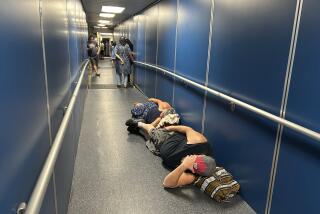Outer Space Outage Signals Growing Dependence on Satellites
- Share via
In the 50 years since legendary science fiction writer Arthur C. Clarke proposed the idea of bouncing communications signals off a relay station in space, Americans have come to rely on satellites to do such everyday things as watching TV, using pagers and talking on wireless phones.
The country’s dependence on satellites has increased quietly, and it is expected to become even greater as high-tech companies roll out a new array of services--like high-speed Internet access--that make use of the floating robots.
But the outage of a single PanAmSat satellite hovering 22,300 miles above Earth brings into sharp focus the fragility of the nation’s telecommunications infrastructure. Since the Galaxy 4 satellite went down Tuesday afternoon, radio listeners, gasoline buyers and especially paging customers have learned the hard way some of the behind-the-scenes ways that satellites affect their daily lives.
“It touches a lot of aspects of life that people don’t realize because they’re not directly interfacing with the technology or space side of it,” said Clayton Mowry, director of the Satellite Industry Assn. in Alexandria, Va.
Engineers from PanAmSat will continue to work today to fix Galaxy 4, and the company said it could take a week to repair the craft or transfer the services it handled to other satellites in its fleet.
Despite the mystique of operating in space, satellites are relatively straightforward devices that relay signals from one place on Earth to another. They are the equivalent of giant radio transmission towers tall enough to cover an entire continent.
A dish-shaped uplink station beams a signal--be it a video stream or a digital data file--up to a satellite. The satellite changes the signal’s frequency to avoid interference with other signals, amplifies the frequency to make it louder and sends it back to another station on the ground.
For a satellite to relay a signal, its antennas must be pointed at the Earth, even as the gravitational forces of the sun, the moon and other heavenly bodies try to pull it out of place. A sensor on Galaxy 4 keeps an electronic eye focused on the big blue planet and makes sure it stays within view. If it moves, a group of spinning momentum wheels acts like a gyroscope to align the satellite back into place.
Instead, Galaxy 4 is spinning like a top, rotating once every three minutes. As a result, its antennas periodically lose sight of the Earth, essentially rendering the multimillion-dollar craft useless.
Dozens of engineers from PanAmSat and Hughes Space and Communications, the El Segundo company that manufactured the satellite, are trying to figure out why the on-board computer that keeps Galaxy 4 continuously pointed to Earth has failed--along with the backup computer installed for just such an occasion.
To find out, trouble-shooting engineers are sending programming instructions to the craft and poring over the data that are sent back. If the problem turns out to be software-related, it can probably be fixed. In the more likely event that the culprit is a hardware failure--engineers suspect the control electronics--chances are greater that Galaxy 4 will become a $250-million piece of space junk.
Ironically, the 167 Hughes-made HS-601 satellites, including Galaxy 4, have had such a good track record that investigators have very little comparative data to rely on as they try to fix the problem.
“This model and models similar to it have hundreds of flight years of experience, and the Hughes line of spacecraft have never experienced a sudden in-orbit failure,” said Robert Bednarek, PanAmSat’s chief technology officer.
Although the Galaxy 4 failure is certainly dramatic, satellites on the whole are more reliable than ground-based communications and data-relay networks. A backhoe could break a fiber-optic cable buried in the ground, and a severe storm can knock over phone lines.
The industry group estimates that there are nearly 300 commercial satellites in operation, yet the majority of paging companies were served solely by Galaxy 4. That’s because it was the first satellite to combine digital technology with a high-power signal that could blanket North America, and all of the major companies wanted to use it, said Jay Kitchen, president of the Personal Communications Industry Assn. in Alexandria, Va. Today, paging companies have more choices, so it is unlikely that a single satellite failure could devastate the industry again, he said.
The small minority of pager users whose service providers do not use satellites were unaffected by the Galaxy 4 problem. Between 10% and 20% of paging companies deliver electronic messages solely by bouncing them off a series of transmission towers planted firmly on the Earth.
Paging is hardly the only consumer convenience delivered via satellite technology.
Live news reports are made possible by satellite uplinks from TV station vans. Radio stations depend on satellites to provide music to listeners. Retailers rely on satellites to update inventory databases and to verify credit cards and checks as they ring up sales. Weather reports--including critical El Nino measurements of ocean water temperatures--come from data supplied by satellites.
Airplanes use signals from Global Positioning System, or GPS, satellites to get from one airport to another. Even massive cargo ships rely on satellites to navigate across featureless oceans.
Analysts say that’s just the tip of the iceberg for satellite-enabled services. Already, rental cars are outfitted with electronic maps that use GPS data to provide real-time directions. A new breed of personal communications, or PCS, services combines the features of cellular phones and pagers. Hughes and other firms have begun using satellite conduits to link computers to the Internet.
But satellite manufacturers like Hughes, Lockheed Martin and Loral can’t build the birds as fast as customers want them. Even after the satellites are built, it can take months or even years before a launch opportunity arises. The whole cycle from ordering a satellite to using it in space takes three to five years, and there’s almost nothing that companies can do to speed that process, said Fred Dassler, executive director of the International Assn. of Satellite Users and Suppliers in McLean, Va.
But despite such hurdles, there is no question that technological and economic forces are driving Americans to depend on satellites more, not less.
“There will be a perpetual expansion of satellite use because it does a job that nothing else can do,” Dassler said. “Every problem we have in transportation or communications is usually the last mile to the user. Satellites have effectively overcome that because they land the signal right where the user is, and that makes a huge difference.”
* PAIN WAS WIDESPREAD: The disruptions reached far into the economy. D1
* WALL ST. SANGUINE: Paging companies’ stock prices suffered only modestly. D1
* SOUNDS OF SILENCE: Shawn Hubler on the loudness of pager-free silence. B1
(BEGIN TEXT OF INFOBOX / INFOGRAPHIC)
Losing a Link
The failure of PanAmSat’s Galaxy 4 knocked out service to pagers, TV stations, radio networks and banks and even caused delays at U.S. airports. A sampling of companies who lost service:
* Asia Radio Network USA/KBLA-AM (Los Angeles-Korean programming)
* KGIL-AM (Los Angeles-continuous Beatles)
* XPRS-AM (Los Angeles-Spanish entertainment)
* The WB Television Network
* Telemundo
* CNN Airport channel
* Minnesota State Lottery
* Michigan Instructional Television Network
****
SATELLITE AID
[1] The Galaxy 6 satellite is being moved to [2] the crippled Galaxy 4’s position so it can take over. [3] Meanwhile, some customers have switched to the nearby Galaxy 3-R.
Source: The Westsat Satellite Channel Chart, Hughes Global Services, PanAmSat
More to Read
Inside the business of entertainment
The Wide Shot brings you news, analysis and insights on everything from streaming wars to production — and what it all means for the future.
You may occasionally receive promotional content from the Los Angeles Times.











